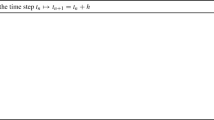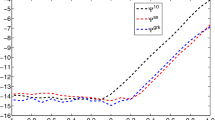Abstract
We propose to use the properties of the Lie algebra of the angular momentum to build symplectic integrators dedicated to the Hamiltonian of the free rigid body. By introducing a dependence of the coefficients of integrators on the moments of inertia of the integrated body, we can construct symplectic dedicated integrators with fewer stages than in the general case for a splitting in three parts of the Hamiltonian. We perform numerical tests to compare the developed dedicated fourth-order integrators to the existing reference integrators for the water molecule. We also estimate analytically the accuracy of these new integrators for the set of the rigid bodies and conclude that they are more accurate than the existing ones only for very asymmetric bodies.










Similar content being viewed by others
References
Blanes, S., Casas, F., Murua, A.: Splitting and composition methods in the numerical integration of differential equations. Boletin de la Sociedad Espanola de Matematica Aplicada SeMA 45, 89–145 (2008)
Buchberger, B.: Ein Algorithmus zum Auffinden der Basiselemente des Restklassenringes nach einem nulldimensionalen Polynomideal (An algorithm for finding the basis elements of the residue class ring of a zero dimensional polynomial ideal). PhD thesis, Mathematical Institute, University of Innsbruck, Austria, English Translation in Journal of Symbolic Computation, Special Issue on Logic, Mathematics, and Computer Science: Interactions. Vol. 41, Number 3–4, pp. 475–511, 2006 (1965)
Celledoni, E., Fassò, F., Säfström, N., Zanna, A.: The exact computation of the free rigid body motion and its use in splitting methods. SIAM J. Sci. Comput. 30(4), 2084–2112 (2008)
Dullweber, A., Leimkuhler, B., McLachlan, R.I.: Symplectic splitting methods for rigid body molecular dynamics. J. Chem. Phys. 107(15), 5840–5851 (1997)
Eisenberg, D., Kauzmann, W.: The Structure and Properties of Water. Clarendon Press, Oxford (1969)
Farrés, A., Laskar, J., Blanes, S., Casas, F., Makazaga, J., Murua, A.: High precision symplectic integrators for the solar system. Celest. Mech. Dyn. Astron. 116, 141–174 (2013)
Fassò, F.: Comparison of splitting algorithms for the rigid body. J. Comput. Phys. 189(2), 527–538 (2003)
Hairer, E., Vilmart, G.: Preprocessed discrete Moser–Veselov algorithm for the full dynamics of a rigid body. J. Phys. A Math. Gen. 39(42), 13225–13235 (2006)
Hairer, E., Lubich, C., Wanner, G.: Geometric Numerical Integration: Structure-preserving Algorithms for Ordinary Differential Equations, Springer Series in Computational Mathematics, vol. 31. Springer, Berlin (2006)
Jacobi, C.G.J.: Sur la rotation d’un corps. Journal für die reine und angewandte Mathematik 1850(39), 293–350 (1850)
Koseleff, P.V.: Calcul formel pour les méthodes de Lie en mécanique hamiltonienne. PhD thesis, École Polytechnique (1993)
Koseleff, P.V.: Exhaustive search of symplectic integrators using computer algebra. Integr. Algorithms Class. Mech. Fields Inst. Commun. 10, 103–119 (1996)
McLachlan, R.I.: Explicit Lie–Poisson integration and the Euler equations. Phys. Rev. Lett. 71(19), 3043–3046 (1993)
McLachlan, R.I.: On the numerical integration of ordinary differential equations by symmetric composition methods. SIAM J. Sci. Comput. 16(1), 151–168 (1995)
Munthe-Kaas, H., Owren, B.: Computations in a free Lie algebra. Philos. Trans. R. Soc. Lond. Ser. A 357(1754), 957–981 (1999)
Omelyan, I.P.: Advanced gradientlike methods for rigid-body molecular dynamics. J. Chem. Phys. 127(4), 044102 (2007)
Reich, S.: Momentum conserving symplectic integrators. Physica D 76(4), 375–383 (1994)
Sheng, Q.: Solving linear partial differential equations by exponential splitting. IMA J. Numer. Anal. 9(2), 199–212 (1989)
Skokos, C., Gerlach, E., Bodyfelt, J.D., Papamikos, G., Eggl, S.: High order three part split symplectic integrators: efficient techniques for the long time simulation of the disordered discrete nonlinear Schrödinger equation. Phys. Lett. A 378, 1809–1815 (2014)
Sofroniou, M., Spaletta, G.: Derivation of symmetric composition constants for symmetric integrators. Optim. Methods Softw. 20(4–5), 597–613 (2005)
Suzuki, M.: Fractal decomposition of exponential operators with applications to many-body theories and Monte Carlo simulations. Phys. Lett. A 146, 319–323 (1990)
Suzuki, M.: General theory of fractal path integrals with applications to many-body theories and statistical physics. J. Math. Phys. 32, 400–407 (1991)
Tang, Y.F.: A note on the construction of symplectic schemes for splitable Hamiltonian. J. Comput. Math. 20(1), 89–96 (2002)
Touma, J., Wisdom, J.: Lie–Poisson integrators for rigid body dynamics in the solar system. Astron. J. 107, 1189–1202 (1994)
Yoshida, H.: Construction of higher order symplectic integrators. Phys. Lett. A 150(5–7), 262–268 (1990)
Author information
Authors and Affiliations
Corresponding author
Ethics declarations
Conflicts of interest
The authors declare that they have no conflict of interest.
Additional information
Publisher's Note
Springer Nature remains neutral with regard to jurisdictional claims in published maps and institutional affiliations.
Solutions for the fourth-order integrators N
Solutions for the fourth-order integrators N
For each fourth-order integrator N of Sect. 3.2, the values of the coefficients \(a_i\), \(b_i\), \(c_i\) are given by the following equations for moments of inertia determined by the values of \(1+x=I_1/I_2\) and \(1+y=I_1/I_3\).
1.1 N1: ABABCBABA
1.2 N2: ABACACABA
1.3 N3: ABACBCABA
1.4 N4: ABCABACBA
1.5 N5: ABCACACBA
1.6 N6: ABCBABCBA
1.7 N7: ABCBCBCBA
Rights and permissions
About this article
Cite this article
Laskar, J., Vaillant, T. Dedicated symplectic integrators for rotation motions. Celest Mech Dyn Astr 131, 15 (2019). https://doi.org/10.1007/s10569-019-9886-4
Received:
Revised:
Accepted:
Published:
DOI: https://doi.org/10.1007/s10569-019-9886-4




